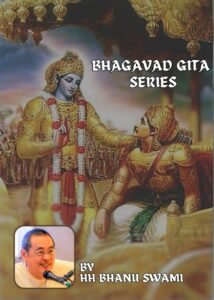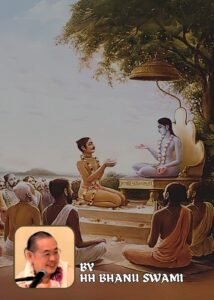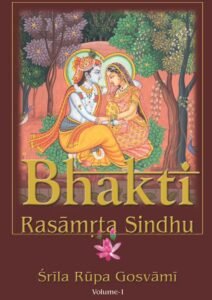Text 3
niśamya bhīṣmoktam athācyutoktaṁ
pravṛtta-vijñāna-vidhūta-vibhramaḥ
śaśāsa gām indra ivājitāśrayaḥ
paridhyupāntām anujānuvartitaḥ
Translation
Mahārāja Yudhiṣṭhira, after being enlightened by what was spoken by Bhīṣmadeva and Lord Śrī Kṛṣṇa, the infallible, engaged himself in matters of perfect knowledge because all his misgivings were eradicated. Thus he ruled over the earth and seas and was followed by his younger brothers.
Purport
The modern English law of primogeniture, or the law of inheritance by the firstborn, was also prevalent in those days when Mahārāja Yudhiṣṭhira ruled the earth and seas. In those days the King of Hastināpura (now part of New Delhi) was the emperor of the world, including the seas, up to the time of Mahārāja Parīkṣit, the grandson of Mahārāja Yudhiṣṭhira. Mahārāja Yudhiṣṭhira’s younger brothers were acting as his ministers and commanders of state, and there was full cooperation between the perfectly religious brothers of the King. Mahārāja Yudhiṣṭhira was the ideal king or representative of Lord Śrī Kṛṣṇa to rule over the kingdom of earth and was comparable to King Indra, the representative ruler of the heavenly planets. The demigods like Indra, Candra, Sūrya, Varuṇa and Vāyu are representative kings of different planets of the universe, and similarly Mahārāja Yudhiṣṭhira was also one of them, ruling over the kingdom of the earth. Mahārāja Yudhiṣṭhira was not a typically unenlightened political leader of modern democracy. Mahārāja Yudhiṣṭhira was instructed by Bhīṣmadeva and the infallible Lord also, and therefore he had full knowledge of everything in perfection.
The modern elected executive head of a state is just like a puppet because he has no kingly power. Even if he is enlightened like Mahārāja Yudhiṣṭhira, he cannot do anything out of his own good will due to his constitutional position. Therefore, there are so many states over the earth quarreling because of ideological differences or other selfish motives. But a king like Mahārāja Yudhiṣṭhira had no ideology of his own. He had but to follow the instructions of the infallible Lord and the Lord’s representative and the authorized agent, Bhīṣmadeva. It is instructed in the śāstras that one should follow the great authority and the infallible Lord without any personal motive and manufactured ideology. Therefore, it was possible for Mahārāja Yudhiṣṭhira to rule the whole world, including the seas, because the principles were infallible and universally applicable to everyone. The conception of one world state can only be fulfilled if we can follow the infallible authority. An imperfect human being cannot create an ideology acceptable to everyone. Only the perfect and the infallible can create a program which is applicable at every place and can be followed by all in the world. It is the person who rules, and not the impersonal government. If the person is perfect, the government is perfect. If the person is a fool, the government is a fool’s paradise. That is the law of nature. There are so many stories of imperfect kings or executive heads. Therefore, the executive head must be a trained person like Mahārāja Yudhiṣṭhira, and he must have the full autocratic power to rule over the world. The conception of a world state can take shape only under the regime of a perfect king like Mahārāja Yudhiṣṭhira. The world was happy in those days because there were kings like Mahārāja Yudhiṣṭhira to rule over the world.
HH Bhanu Swami Maharaj :
So this verse is describing the rulership of Yudhiṣṭhira after he fought the battle of Kurukṣetra and he became the king. This is nothing new, the whole of Bhāgavatam , Bhāgavatam later on we’ll see is a discussion of how a succession of kings ruled who were descendants from Manu. So in the third and fourth cantos there’s a whole discussion of how first Svayambhuva Manu became the king and then his descendants like Priyavrata and Dhruva ruled over the earth. Now this is actually one of the ten topics of Bhāgavatam called Manvantaram.
So there are fourteen divisions in the day of Brahmā called Manvantara periods. And they consist of, each one consist of about seventy one yuga cycles. And at the beginning of each cycle of seventy one yuga cycles, a Manu ascends the throne and he starts a dynasty. So his sons and grandsons continue for seventy one yuga cycles. And during that time, activities such as the appearance of different avatars takes place. So in this way Bhāgavatam gradually describes the progression of Manvantaras with different avatars appearing until we come to our particular Manvantara, Vaivasvata Manvantara.
And then within the descendants of Vaivasvata Manu, they continued until we come to the present time. So just before Kali Yuga, the dynasty began to get disrupted. And Yudhiṣṭhira should have been the rightful king as a descendant from Manu.
But there was opposition and therefore the battle of Kurukṣetra took place. And through that, Yudhiṣṭhira was established as the rightful descendant from Manu. But unfortunately, not only was this a very critical time with the end of Dvāpara Yuga, beginning of Kali Yuga, but also Kṛṣṇa disappeared. So when Yudhiṣṭhira heard that Kṛṣṇa disappeared, he also disappeared. But he established his descendant on the throne, that is Parikṣit. And that is discussed later in this canto.
And then Parikṣit heard Bhāgavatam from Sukadeva Goswāmi. So all of these incidents in the first canto are related to lead up to appearance of Parikṣit parikṣit and then śukadeva teaching him Bhāgavatam. So the whole story of this conflict is detailed in Mahābhārata.
And the discussions between Bhīṣmadeva and Yudhiṣṭhira are in detail in the Mahābhārata . So that whole story is incidental to Bhāgavatam. And the main concentration of Bhāgavatam is this conversation between Parikṣit and Śukadeva Goswami. But in order to give that a context, we have this whole story of battle of Kurukṣetra and Yudhiṣṭhira and Parikṣit.
So the Lord produces the material world and of course it is material, so therefore subject to destruction. But the Lord gives some help or assistance to the world. And he restores things once the system begins to decline. So the Lord is in charge of the material world and he plans everything out very nicely and he maintains the world. And he protects the human population.
There are many ways he does this. Of course one way is he manifests the Vedas so people can get knowledge. Another is he comes as avatar and he destroys the big demons. Another way is he installs the Manus and their descendants. These kings rule according to Dharma and Bhakti. In this way, there is a very good chance that the human beings can advance through varṇāśrama system and become devotees.
The nature of the material world is it is unstable. Sometimes Sattvaguna is prominent, sometimes Rajoguna is prominent, sometimes Tamoguna is prominent. When Rajoguna and Tamoguna become prominent, the demons become very powerful. We see Bali Mahāraj ended up getting to the heavenly planets. We see great demons like Hiranyakaśipu disturb the heavenly planets. And then just before Kali Yuga, Kamsa became very powerful so the Devatas went and complained to the Supreme Lord.
So to restore the order, the Lord comes as avatar kṛṣṇa and then he also installs Yudhiṣṭhira as the king. So these are ways in which the Supreme Lord gives mercy to the human beings. He may act directly and kill demons. Or may he empower his devotees like Yudhiṣṭhira , Arjuna and Bhīma. But by performing his activities, he helps to restore order within the universe. And this of course is the responsibility of the Devatas. They manage the whole universe and they are Sattvic. So the Devatas are empowered by the Supreme Lord. They are called Vibhūtis of the Lord. Supreme Lord also empowers Manu and his descendants. They are also Vibhūtis of the Lord.
And thus these empowered human beings, that is descendants of Manu including Yudhiṣṭhira, they are able to rule perfectly. Sometimes we also get special rulers. They become outstanding devotees.
So we get outstanding devotees like Dhruva or Ambarish. And Yudhiṣṭhira . And though they are empowered to rule over as descendants of Manu, at the same time they are very great devotees. And in Bhāgavatam they are famous because of their devotion. So we find in these personalities a very nice combination. They are empowered to rule plus they have great devotion to the Lord.
And thus they become famous. When we come to Kali Yuga, there is a big problem. We see that Parikṣit prevented the problem. Kali was not able to influence. But later in the Bhāgavatam, we have a description that happened later on. The line of kings was disrupted. And finally the last descendant from Manu disappeared. And we get as described here by Śrila Prabhupāda, all sorts of people trying to rule but not being qualified. So not only we have the problems of Kali Yuga, such as stratification, lack of intelligence and lack of long life, but we get no good government.
And we see as Kali Yuga progresses, it gets worse. So then what are we supposed to do? No avatar at the moment and Manu’s descendant is not there. So there is nobody to rule.
So it looks hopeless. But Bhakti is not subject to any condition. So whether it is Kali Yuga or Satya Yuga, Bhakti can continue. Whether there is an authorized king or no authorized king, Bhakti can continue. However, in Kali Yuga, the easiest way we perform Bhakti is through Nāma Sankirtana. So this becomes the savior for Kali Yuga.
And thus, Nāma Sankirtana is also considered to be avatar of the Lord. So though we don’t have an avatar at the present moment, by doing Nāma Sankirtana, we have the protection of the Supreme Lord. So this is the teaching of Caitanya Mahāprabhu. It is also the conclusion of Srimad Bhāgavatam. So this is the way in which Supreme Lord protects the people in Kali Yuga.
Q&A
1) Did anyone write manu smṛti?
There are 19 Smṛitis. There is Manu Smriti, Viṣṇnu Smriti, ankara Smriti, Yajñavalkya Smriti, whatever, so many. And the Acharyas sometimes quote from them, all written by sages.
The great sages also are considered to be vibhūtis of the Lord. So we have sages, devatas, and Manus and their descendants. They are all empowered by the Lord.
2) Most of the time I feel that I am seated in Mode of ignorance. How to work on this?
Well, bhakti is beyond all guṇas. Other methods are within the gunas. Even jñāna, which is supposed to give liberation, arises from sattva guṇa.
Bhakti is very special. It is nirguṇa. Bhakti is special. It is nirguṇa. It is actually svarūpa śakti of kṛṣṇa. So, bhakti comes into the material world. It is actually spiritual. And if we take the process of bhakti, we become spiritual beyond the guṇas.
We have gradual processes to take us out of guṇas. So through the varṇāśrama system one can go from tamoguṇa to sattvā guṇā but it might take few lifetimes. Lifetimes. So, the quickest way to go from tamo guna, beyond sattva guna, to the śuddha sattva level, is through the process of bhakti. And within bhakti, then, nāma sankirtana is the most powerful process. So, nāma sankirtana is glorified as the best vratta, the best tapasya, the best yoga, the best śama and dama, that is the best way to control the mind and the senses.
3) In the 71 yuga cycles of one manu, this kali yuga also included, but they have to rule, but they disappeared. But the nāma appeared as yuga avatar. We are taking shelter of nama. We are protected by this. but some people misuse the holy name of the lord. So, how can we understand their position?
Yes, the main process is Nāma Sankirtana Some people reject the name some people offend the name or misuse the name, but what can we do? Even in satya yuga, supposed to be very nice Still we have demons
So, The world, in any case, whether it is Satya, treta, Dvāpara, Kali will have some obstacle there. Swargaloka always sattva, but sometimes demons come up there and disturb also. So definitely in Kali Yuga we can never expect perfect circumstance.
4) To commit the sin on the strength of holy name, could you explain how can we refrain from that considering that all the works in kali yuga are mlecchas work.
Ultimately the protection from everything is Nāma Sankirtana. There are other processes like yoga and whatever, but ultimately the most effective way for everything is Nāma saṇkīratana.
Devotees: Grantharaj Srimad Bhagavatam Ki.. Jai ! Srila Prabhupad Ki.. Jai !!


